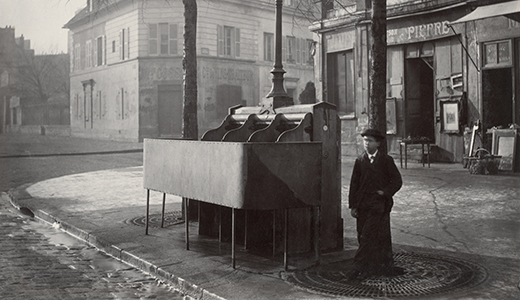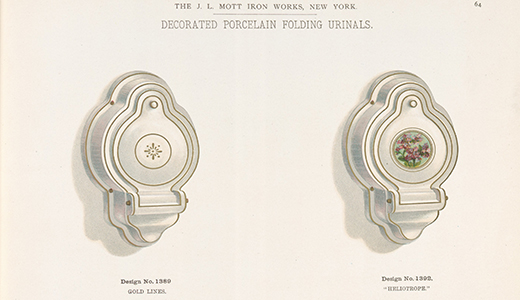 2018
2018
Slate urinal with three stalls, Chaussée du Maine, c. 1865. Photograph by Charles Marville. State Library of Victoria, Gift; Government of France; 1881.
Locals in Paris are reportedly planning to petition the new “urinoirs” on the Île Saint-Louis, where (male) passersby desperate to relieve themselves may do so while looking at the Seine. The sidewalk urinals, or “Uritrottoir,” are fire-engine red and look like garbage cans. A flower garden perches on top of the receptacle, a bit of decor that hasn’t stopped those who live or work by the exposed urinals from calling them an effrontery to morals, an invitation to exhibitionism, or simply sexist. The designer of the Uritrottoir previously told The Guardian that we might be past the time of being revolted: “Drunk blokes just keep pissing. People may laugh at our solution, but it could just work.” From Reuters:
“There’s no need to put something so immodest and ugly in such an historic spot,” said Paola Pellizzari, sixty-eight, owner of a Venetian art store.
“It’s beside the most beautiful townhouse on the island, the Hôtel de Lauzun, where Baudelaire lived,” she said, referring to the nineteenth-century French poet.
She feared the urinal, installed about twenty meters from a primary school, “incites exhibitionism.”
The designer of the “Uritrottoir”—a combination of the French words for urinal and pavement—said it offered an “eco solution to public peeing.”
The device is essentially a box with an opening in the front and a floral display on top containing straw which transforms into compost for use in parks and gardens.
But residents and businesses of Île Saint-Louis said the receptacle, with no stall around it of any kind, could blight the neighborhood.
“It’s horrible,” said the fifty-year-old owner of a nearby art gallery, who declined to give his name. “We’re told we have to accept this but this is absolutely unacceptable. It’s destroying the legacy of the island. Can’t people behave?”
 1855
1855
Decorated porcelain folding urinals, 1884. The New York Public Library, Science, Industry and Business Library.
After the 1832 cholera epidemic, the administrators of Paris tried to temper the teeming stink of the city streets with a bit of hygienic innovation. Claude-Philibert Barthelot, prefect of the Seine, installed pissoirs, or public urinals, that became ubiquitous as the nineteenth century rolled forward. Situated on boulevards, they weren’t very private, often concealing users only from shoulder to knee. Other smelly cities took note and tried to keep urine off the streets with similar structures. As Boston found out, however, residents were less than enthused about hosting such a breakthrough in their backyard. From the Boston Medical and Surgical Journal, as reprinted in the New York Times:
PUBLIC URINALS AND THE CITY GOVERNMENT.—We alluded, in a later number, to the want of privies and urinals, so situated that the inhabitants of our crowded streets might avail themselves of them, instead of converting our highways into receptacles of filth, and endangering public morals, as well as health and comfort. We take great pleasure in stating that it is from no lack of effort on the part of the city Government that these abuses exist in Boston. Soon after the present mayor (the senior editor of this Journal) came into office, two excellent urinals, after the Paris plan, were constructed, and orders given to locate them in convenient places; but no abuttor would consent to have one placed before his premises. Next, the Superintendent of Internal Health was directed to erect one on the southerly side of the way from Tremont Street to Pemberton Square—where there is a perpetual nuisance from a rivulet of urine; but the way being private property, consent could not be gained, and that locality was reluctantly abandoned. At various points on Washington Street, and other places where the mass of human beings demand some kind of convenience of the sort, no one would tolerate an iron urinal. In a word, the assurances were so strong and determined, that if erected, no police-watching could protect it, that the Mayor was compelled to relinquish the enterprise and the urinals are dead property on hand. Under these circumstances, it would be impossible to keep one standing a single week. It is in vain to hope for any improvement in this department of public hygiene, so long as our citizens remain in such a state of apathy on the subject. If the abuttors prefer to have streams of urine running over their sidewalks, in place of a not-inelegant structure, which would free them from such a nuisance, we can only lament their want of taste, and wait patiently for times of greater enlightenment.